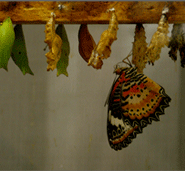This year, The Fuschia Tree's issues tackle 'The Unseen': seemingly invisible and tangential ideas that change the course of our lives. If there is an Unseen that has preoccupied you, or affected you deeply and you would like to have us create stories around it, feel free to email us at . The Choice, after all, is yours.
Perform. Uniform. Formal. Inform. Reform. Formula. Transform.
Conform.
The word, form, itself lies hidden within words even as it creates them.
One does not see a formula, though it is instrumental in providing a conclusion; a form is a box one fills for an objective external to itself. Form, as an idea, is an underlying structure, an invisible brace holding otherwise floating elements together, like a rib cage its lungs.
Form is a bookshelf holding books, a spine of a book holding its pages. It is the architecture after the architect.
Just as gravity holds the earth down even as it floats in some larger space; just as the body holds a consciousness, even as it daydreams outside of it.
It is a line bent into a symbol, droplets of mercury constrained in a thermometer.
It is a molecular bond, it is our minds finding habit.
In human design, form is a deliberate element of composing, yet the most successful work aspires to conceal it, so that the audience, while struck by the complexity and control of a piece of music or a dance, is never overtly aware of its form.
In this issue, we look at Form particularly in Performance (etymology: through-form), where the body interacts with the space that forms it, creating a language through the shape of gesture and the lines of time.
We open with Niranjani Iyer, a performer and choreographer, telling a heartfelt story of her emergence into dance through the amoebic presence of Pina Bausch, there and gone, there and gone.
We offer you sometimes acute and sometimes obtuse angles into the movement mechanisms of Zuleikha Chaudhari's dancing structures and Padmini Chettur's structural dancing.
Sumit Baudh talks to TFT about performing the multiple characters of his life, and his newly constructed, self-reflexive, projectionist character in drag for the art space.
Finally Rattanamol Singh Johal recounts his experience with blindness and the city; how a single sense reduced might heighten all else, and new perceptions of an old city via an experiment in light and the body.
Form is the most hidden of the Unseens, and yet its presence is elemental and overwhelming. When my shoulders are clenched and my back stiffens as you enter the room, you know my eyes will pale at the sight of you. The obstacle in my back hinders my love. Necessarily, the body contains, masks and reveals everything of thought and desire.
So loosen your limbs and let the weight of your body hold you. Everything else will enter, then will you.
Afformatively,
Himali.


